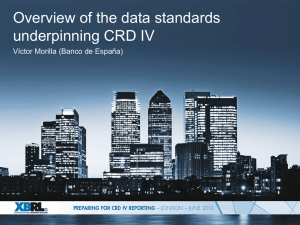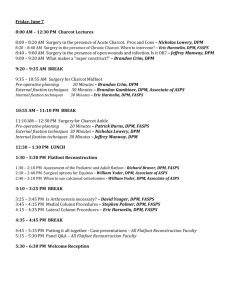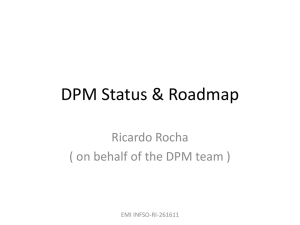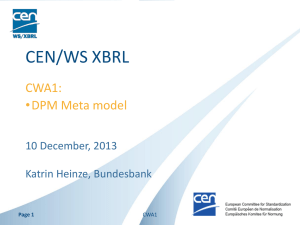How understand a DPM
advertisement
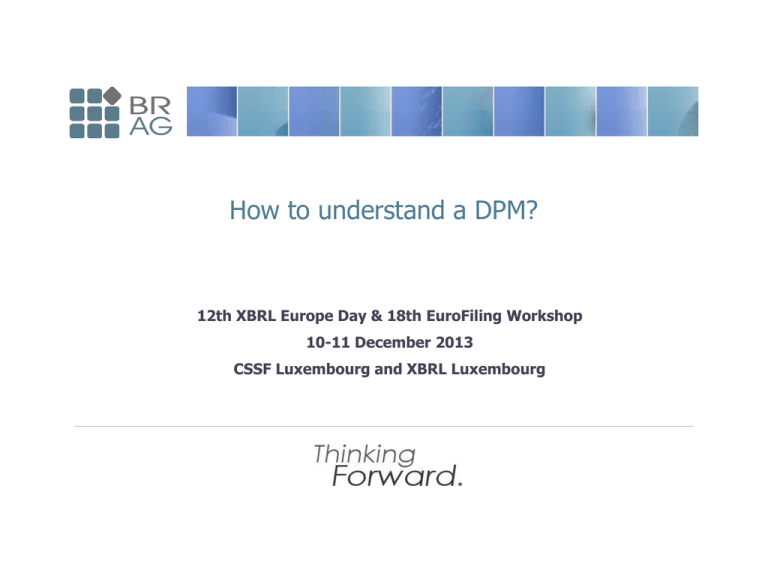
How to understand a DPM? 12th XBRL Europe Day & 18th EuroFiling Workshop 10-11 December 2013 CSSF Luxembourg and XBRL Luxembourg What are the questions asked by business and IT experts? • • • • • • • • • Business users IFRS, FINREP, COREP, … - which accounting regime or standard? What do you mean by „financial” (IAS 39/IFRS7/...)? Where is it disclosed? Gross or net carrying amount? Any of it impaired or past due but not impaired yet? Or maybe it is measured at fair value? If so: which level? Which operations is it reported for? Banking book, assets management, ...? Is any of it portion transferred or partially derecognized? Is it audited or unaudited, solo or consolidated (if consolidated then which method)? … 2006 – 2013 © Business Reporting – Advisory Group „Financial assets” • • • • • • • IT Is it a number, date, text? If a number that what is the unit of measure? How is it related to other data – which package does it come with (frequency, types of entities)? Does it calculate to or from anything else? Are there any breakdowns applicable? Are they predefined or flexibly assigned by filers? What attributes apply to this data? How is it characterised? Which journal-entries roll-up to this value? … 2 Business vs. IT issue is not the only challenge in EU… Banking supervision Insurance supervision Capital market supervision Country 1 Business expert IT expert Business expert IT expert Business expert IT expert Challenges: - Different sectors (i.e. Basel III vs. Solvency II) Country 2 Business expert IT expert (…) - High number of countries (European vs. global initiatives) - Frameworks (Basel vs. IFRS) - Other (i.e. proportionality rule, solo vs. consolidated reporting, etc.) Country 28 Business expert 2006 – 2013 © Business Reporting – Advisory Group IT expert 3 What are the options of dealing with the problem of communication? "form centric" • based on presentation of data which conveys all semantics (interpretation in context of views) • description based on table cells (row/column code, e.g. C6 or simply by row/column title concatenation) • most common solution in projects with no input from business experts • difficult to maintain and apply e.g. for analysis C1 C2 • fillers map/extract to/from views R1 (question and error prone) R2 R3 "data centric" • explicit and consistent definition irrespective of presentation • every data cell fully described by business users with all necessary properties in order to explicitly express its meaning • resulting data model supports data exchange (explicit information for filers) and usage (e.g. in analysis) 2006 – 2013 © Business Reporting – Advisory Group 4 How to approach data centric modeling? SELECT SUM(factValue) FROM allFacts WHERE item=″assets″ AND category=″loans″ AND amount=″notional″ AND … 2006 – 2013 © Business Reporting – Advisory Group 5 Data point model What DPM is? • Methodology to organize the data • Must include: • Dictionary (consistent, well structured, no overlaps, etc.) • Mechanism to describe data model (tables) with concepts from the dictionary (unique, explicit, etc.) What DPM is not? • Technical format • Tables • „Something” to be prepared by IT experts… 2006 – 2013 © Business Reporting – Advisory Group 6 What is the data point? Combination of (i) a measure/metric and (ii) sets of pairs of each applicable dimension and domain members describing this measure in order to explicitly define a piece of information (e.g. a cell in a template) Measure/metric: shall cover data type, instant vs. duration, should cover basic business meaning that could be detailed • using breakdowns Domain: consists of domain members sharing semantic nature (e.g. countries, currencies, portfolios) • • Domains should not overlap (consistency of model) • Domain should have a default member identified • Domains can be divided into subdomains, which purpose can be: - disaggregation (with ‚+’ or ‚–’ sign) of a total (e.g. counterparty sector or residence) - indicating certain notion (property) of a base item (e.g. solo vs. CRD consolidated vs. IFRS consolidated reporting scope, …) • Domains can be explicit or typed - typed domains are used to allow reporting of unlimited number of rows/columns/tables • Dimension: a view on a domain member (and related metric) from a certain perspective • e.g. EUR as (i) original currency of exposure or (ii) currency of collateral delivered • There can be only one domain referenced by single dimension 2006 – 2013 © Business Reporting – Advisory Group 7 What are domains, subdomains, dimensions? Subdomain 1: All (…) Spain Other than Spain Subdomain 2: All EMU Spain Other than Spain in EMU (…) Other than EMU (…) Dimensions: Location of activity Securitization partner residence Counterparty residence Domain: Geographical and political areas - All - EMU (…) - Spain - Other than Spain - Other than Spain in EMU (...) - Other than EMU (…) 2006 – 2013 © Business Reporting – Advisory Group 8 Everything is a perspective… Portfolio breakdown (purpose and measurement) • e.g. held for trading - „acquired or incurred principally for the purpose of selling or repurchasing it in the near term”; includes different instruments: Derivatives, Loans, Debt securities, Equity instruments, … portfolios main Instruments breakdown: categories • e.g. debt instrument - held-for-trading „contractual or written assurance to repay a debt”; can designated at fair value loans fall into different portfolios: Held-for-trading, Designated at fair value, Available for sale, … derivatives available-for-sale debt securities assets assets: property, resources, goods, etc that a company possesses and controls, e.g. financial instruments owned by a reporting entity that shall generate economic benefits in the future 2006 – 2013 © Business Reporting – Advisory Group liabilities income/ expense base concepts liabilities: sources of funding for company’s assets and operations, e.g. financial instruments that have been issued by a reporting entity, thus represents an obligation that needs to be settled in the future by a transfer of some assets (such as cash) from the entity income/gains or expenses/losses: economic benefits that occurred during the period and originated from increase/decrease in value or result on sales/purchase of a given financial instrument 9 Let’s try to define a data point for: Net carrying amount of not yet impaired but already past due (over 180 days but less than a year) debt securities held, issued in EUR by MFIs located in EMU with original maturity under one year, measured at amortised cost and relating only to business activities conduced in EU? Locations of activities: All / Not-applicable EU Other than EU (…) Portfolios: Total (…) Fair value through profit or loss Amortised cost Base terms: Assets Liabilities Equity Off-balance sheet Exposures Categories: Total (…) Cash Loans Debt securities Equity instruments Tangible and intangible Other than (…) Amount types (metric): Carrying amount Gross carrying amount (Specific allowances) (Collective allowances) Original currencies: All / Not-applicable EUR Other than EUR 2006 – 2013 © Business Reporting – Advisory Group Impairment status: All / Not-applicable Impaired Unimpaired Base term: Assets Category: Debt securities Portfolio: Amortised cost Amount type: Carrying amount Impairment status: Unimpaired Past due period: ≥ 180 days < 1 year Original currency: EUR Original maturity: < 1 year Counterparty sector: MFIs Counterparty residence: EMU Location of activity: EU Time reference: Current period end Time reference: Current period end Previous period end Current period Past due periods: All < 180 days ≥ 180 days < 1 year ≥ 1 year Original maturity: All < 1 year ≥ 1 year < 2 year ≥ 2 years Counterparty sectors: All / Not-applicable MFIs MMFs MFIs other than MMFs Central Administration Other general government Non-MFIs other than government Counterparty residences: All / Not-applicable EMU Other than EMU (…) 10 What is the general process of development of the DPM? 1. 2. purpose of information requirements in general (what is this data for?) analysis documentation (explanatory guidelines for information requirements and notification duties) purpose of a statement/note/disclosure (expressed by its title, describing in general the character of information) intersection of title and headers (of row and column) naming each piece of information recursive: supporting documentation and content of other statements, notes and disclosures allowing identification of implicit information that is not explicitly expressed in an analyzed statement/disclosure location in a hierarchy in headers of rows and headers of column (inheritance), coherent breakdowns (items sharing common semantic nature) minimizing redundancy and maximizing reusability of definitions 2006 – 2013 © Business Reporting – Advisory Group 3. 4. study the information requirements analyze them by statements/disclosures (table by table, header by header according to the divide and conquer approach): A. identify measures (metrics) and list them down (if a measure is already listed – reuse it) identifying type of expected value and measurement in time (instant/duration) B. identify and name all breakdowns required to explicitly define each piece of information • preserve hierarchies (if applicable) with other already defined values (properties) or reuse existing values • if a value is not applicable to any existing hierarchy create a new one review the measures and breakdowns and look for optimization (e.g. breakdowns of similar nature, functional relationships, etc.) add other necessary characteristics Resulting DPM shall contain: Dictionary: – a list of measures (name, label, data and period type, …) and hierarchy of measures (if applicable) – a list of members and dimensions of each domain (name, label, item type, default member) – a subdomains of each domain (subdomain name, hierarchy and order, operators, alternative classifications) Tables/tables coordinates referencing back to the Dictionary 11 How to define the best data model? data modelling it’s not a science! it’s a (subjective) result of discussion... 2006 – 2013 © Business Reporting – Advisory Group ...and agreement! 12 What are the benefits of using DPM? DPM is template independent (data centric) - all information about data point is explicit (easy to communicate) Model is very stable but possible to extend if required (reusing of concepts is priority, adding/extending of concepts/hierarchies is possible as long as it doesn’t break the logic of model) The quality of reporting requirements/templates is improving (consistent labeling, hierarchical structures) 2006 – 2013 © Business Reporting – Advisory Group It is easy to trace the difference between every two data points across entire reporting framework DPM could be a guideline how to organize the data on reporting entity side (storage and BI systems) 13 Sharing DPM dictionaries ECB Statistics FINREP rev 2 FINREP Comprehensive income Fair value level Controling/ Non-controlling Market Transfer Amount interval Loan type Minimum reserve … Portfolio Risk type Impairment Main categories Amount type Currency Collateral Geographical areas Sector Entity code Time intervals Exposure type Line of business Approach/Model used Type of business Securitization type … Diversification COREP Type of contract Change in basic own funds Percentage Intervals Type of claim 2006 – 2013 © Business Reporting – Advisory Group … SOLVENCY II 14 Synthetic comparison of existing DPMs Frameworks Dictionary Components of DPM Amount Most important domains (bold for metric) Base concept Main categories Data type Unstructured lists (domains) and hierarchies (subdomains) in single .xls worksheets Referring back the tables from dictionary BSI-MIR (BdE) Outstanding amount, Revaluation adjustments, etc. Solvency II value, Statutory account, etc. Assets, Liabilities, etc. Assets, Liabilities, etc. Debt securities, Equity instruments, etc. Debt securities, Equity instruments, etc. False True CRD4/CRR (EBA) Carrying amount, Notional amount, etc. Assets, Liabilities, etc. Debt securities, Equity instruments, etc. Not required Not required (incorporated Monetary, String, etc. (incorporated into into Base concept) Amount) DataPointStructure (referencing the dictionary datapoint by datapoint) Format of DPM Excel, XBRL Dropdown lists Not used 2006 – 2013 © Business Reporting – Advisory Group SOLVENCY2 (EIOPA), HD version False Annotated DPM Table Layout and Data Point Categorisation Excel, XBRL, Access Excel, XBRL database Dimension with Metrics with predefined predefined domain values (domain members from existing members from existing subdomain subdomain) Annotated templates 15 Let’s see some DPMs 2006 – 2013 © Business Reporting – Advisory Group Thank you Michal Skopowski michal.skopowski@br-ag.eu http://www.br-ag.eu
